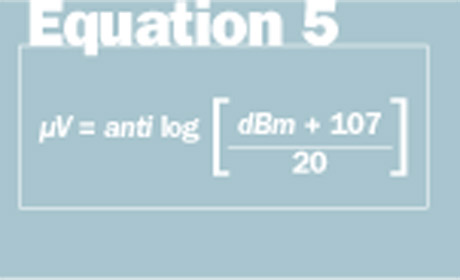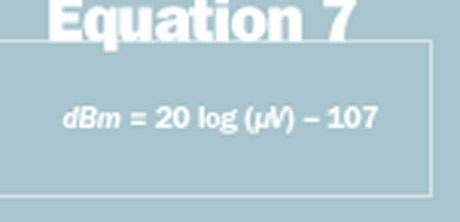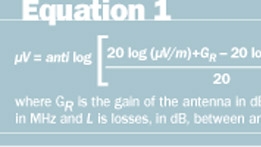Deciphering RF units of measure
It is imperative that wireless communication technicians understand the various units of measurement used to quantify the level or amplitude of a radio frequency, or RF, signal. This article will describe the relationship between several of the more frequently used units of measure and how they are applied in practice.
Suppose the sensitivity of a voice pager is given as 25 µV/m (microvolts per meter) in terms of field strength, or 0.5 µV chassis sensitivity, at a frequency of 160 MHz. From this information, we can determine the amount of gain of the internal antenna in dBd [gain of antenna referenced to a half-wave (λ/2) dipole]. First, we must know how many microvolts would appear across the terminals of a half-wave dipole when placed in a field strength of 25 µV/m. Since we are using a half-wave dipole, GR is equal to 0. The loss (L) is assumed to be 0 dB. Equation 1 provides the formula for calculating microvolts (µV) from microvolts-per-meter (µV/m).


Plugging the given figures into Equation 1 would yield 6.28 µV. Thus, a half-wave dipole in a field strength of 25 µV/m would produce 6.28 µV at the receiver input. According to the specifications, the chassis sensitivity of the pager is 0.5 µV. Thus, we can assume that a field strength of 25 µV/m would produce an input level of 0.5 µV at the pager input. Since a half-wave dipole would produce a level of 6.28 µV, the gain of the pager’s internal antenna can be determined as shown in Equation 2. Thus, the pager’s internal antenna has a gain of -22 dBd. However, a negative gain is actually a loss, so the pager’s internal antenna has a handicap of 22 dB compared with a half-wave dipole.
Testing pager sensitivity presents some difficulty because pager transmitters are very busy and produce very strong signals that can interfere with test results. In addition, many pagers don’t provide a direct input to the receiver for connection to a signal generator. Even if an RF input jack was provided, paging signals in the area might be strong enough to invalidate test results. Thus, the pager must be isolated from extraneous signals.
Generally, pagers are tested in a shielded RF test enclosure or TEM cell that provides a connection (RF jack) through which a signal is fed from a signal generator at a level that produces the required field strength at the pager antenna. Cell phones and other wireless devices are tested in a similar manner, because these types of transmitters are very busy and may produce high RF field strength levels in the test area. Well-shielded screen rooms often are used for testing such devices and must offer very high RF isolation at the frequencies used by the DUT (device under test).
In addition to microvolts-per-meter (µV/m), field strength is sometimes stated in terms of dBu or dBµV/m, which are interchangeable. In these terms, 1 µV/m is the reference for 0 dBu. Therefore, 6 dBu or 6 dBµV/m is equal to 2 µV/m because 2 µV/m is a doubling of the voltage, and doubling the voltage is an increase of 6 dB.
It also is important to determine the level of field strength at the antenna required to produce a given signal level (in microvolts) at the input of a receiver. For example, suppose we have a system operating on a frequency of 460 MHz and the desired signal level at the input of the receiver is 1 µV. The antenna has a gain of 6 dBd, and the cable loss is 2 dB. What field intensity at the antenna will produce 1 µV at the receiver input under these conditions? Equation 3 can be used to compute the required field intensity. Plugging in the values above yields 7.29 µ/m.



It is important to note that frequency is a factor in determining how many microvolts are produced across the antenna terminals from a given field intensity. For example, a field intensity of 20 µV/m will produce approximately 20 µV across the antenna terminals at 40 MHz (assuming a 0 dBd gain antenna).
At 160 MHz, a field intensity of 20 µV/m will produce approximately 5 µV across the antenna terminals (again, assuming 0 dBd antenna gain).
Notice that the signal level appearing across the antenna terminals is inversely proportional to the frequency. In this example, the frequency was multiplied by a factor of 4 while the signal level across the antenna terminals was divided by 4.
If the frequency had been changed to 20 MHz (half of 40 MHz), the signal level across the antenna terminals would have doubled to approximately 40 V. This has to do with the antenna factor, designated by K. At approximately 40 MHz the antenna factor (K) is approximately zero, assuming a 0 dBd gain antenna.
Signal generators often are calibrated in microvolts and dBm. Because the dBm is defined as 1 milliwatt (mW) in 50 , the voltage required to produce 1 mW in 50 is derived from Equation 4.
Thus, 0 dBm is 223,607 µV. You will also find wide usage of the unit dBµV, or decibels referenced to 1 µV. Hence, 1µV is 0 dBµV. As long as we know the reference value, it is relatively simple to calculate the RF level. For example, a value of -50 dBm can be converted to microvolts (µV) by using Equation 5. Plugging in the numbers above yields the result indicated in Equation 6 on page 38, while Equation 7 can be used to convert microvolts (µV) to dBm.
The term dBW also is used to quantify the amplitude of an RF signal. It is simple to convert dBm to dBW — just subtract 30 from the dBm figure to get dBW. That is: dBW=dBm-30. Conversely, dBm=dBW+30.


Often, RF power is stated in terms of dBm or dBW. It is easy to work with these values if we simply remember that 100 W is 50 dBm or 20 dBW. It is simple to convert from dBm to watts by remembering that multiplying or dividing the power by 10 increases or decreases, respectively, the dBm value by 10 dB, and multiplying or dividing the power by 2 increases or decreases, respectively, the dBm value by 3 dB.
For example, 50 W is 47 dBm (this is 3 less than 50 dBm). And, 50 W would be equal to 17 dBW. Just by remembering the 100 W equivalent values of dBm or dBW makes other conversions easy. When working with dBm, it is easier to add or subtract the gains and losses in a system. For example, suppose a transmitter has an output of 40 dBm (10 W). This output is fed through an amplifier with a gain of 15 dB to an antenna with a gain of 6 dBd through a transmission line with a loss of 2 dB. The effective radiated power of the system is 40 dBm + 15 dB – 2 dB + 6 dB = 59 dBm. Because 50 dBm is 100 W in a 50 system and 3 dB equals a doubling of power, we can calculate the final radiated power by multiplying 100 × 2 × 2 × 2 = 800 W.
For a more in-depth treatment of this subject, you can find a PDF file entitled, “Field Intensity” on my Web site, www.radiotechnologies.net. You also can download an RF calculator program in DOS or a Windows-based program in a zip file free of charge. When you get to the home page, click on “More Links” to find the programs and paper mentioned here. Although the information and software are believed to be accurate, the usual disclaimer applies — the author assumes no liability for use of the software or white paper.
Until next time — stay tuned!

















